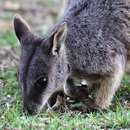en
names in breadcrumbs


Perception Channels: tactile ; chemical
This species of rock wallaby has fairly stable population numbers, rarely reaching low levels. A possible threat to the species is introduced predators during a drought (Delaney 1997a).
US Migratory Bird Act: no special status
US Federal List: no special status
CITES: no special status
IUCN Red List of Threatened Species: least concern
Members of this species use darkness as a cover or shelter when foraging. Breeding pairs have been known to eat together, and feeding individuals also seem to prefer to be near to others with whom they are not breeding (Horsup 1994).
Primary Diet: herbivore (Folivore )
Found only in northern Queensland, Australia (Strahan 1995).
Biogeographic Regions: australian (Native )
Rock dominated terrain in northern Queensland, Australia (Strahan 1995).
Habitat Regions: terrestrial
Terrestrial Biomes: forest
The Allied rock-wallabies may live over seven years in the wild (Delaney 1997a).
Physically, Allied rock-wallabies have large hindfeet, reduced forepaws, and large hindlegs compared to their arms. They stand upright and move bipedally. The coloration may depend on surrounding rock color. They are usually gray-brown on the body with lighter brown underneath and on their appendages, and darker paws and feet. The tail has a brush that becomes darker in coloration towards the end (Strahan, ed. 1995).
Range mass: 4.3 to 4.7 kg.
Range length: 512 to 496 mm.
Other Physical Features: endothermic ; bilateral symmetry
They are seldom threatened by predators.
Known Predators:
Mating System: monogamous
Allied rock-wallabies are usually found in facultative, long-term, monogamous pairs, although females may have extra-pair copulations. They breed continously throughout the year, yet certain times seem to be more common (Spencer et. al 1997).
Range age at sexual or reproductive maturity (female): 23 to 17.5 months.
Range age at sexual or reproductive maturity (male): 23 to 17.5 months.
Key Reproductive Features: year-round breeding ; gonochoric/gonochoristic/dioecious (sexes separate); sexual ; fertilization (Internal )
Average gestation period: 31 days.
Average number of offspring: 1.
As with other marsupials, birth occurs early in the developmental process. At birth, young crawl to a pouch. They stay in the pouch on the teat for roughly 180 to 231 days. Sexual maturity occurs at 23 months for males and 17.5 months for females (Delaney 1997b).
The allied rock-wallaby or Weasel rock-wallaby (Petrogale assimilis) is a species of rock-wallaby found in northeastern Queensland, Australia. It forms part of the P. lateralis/penicillata species complex and is very similar to six other species of rock-wallaby found in this area; these include the Cape York rock-wallaby (P. coenensis), the unadorned rock-wallaby (P. inornata), the Herbert's rock-wallaby (P. herberti), the Godman's rock-wallaby (P. godmani), the Mareeba rock-wallaby (P. mareeba) and the Mount Claro rock-wallaby (P. sharmani).[3][4]
Few features distinguish the allied rock-wallaby from its close relatives but each species lives in a different part of Queensland and northern New South Wales; where their ranges overlap slightly, there is some hybridisation. They all have upper parts that range from brown to grey, and paler underparts. They usually have a dark muzzle and a dark patch around the armpits. On the face is a pale cheek stripe, and across the hips is another pale stripe.[4]
The allied rock-wallaby is endemic to Queensland in Australia. Its range extends from Townsville to the Burdekin River, the Bowen River, Croydon and Hughenden, and includes Magnetic and Palm Islands. It occurs at elevations of up to 1,000 m (3,300 ft) in rocky areas, both in woodland and in more lightly-treed areas, even when agricultural land is nearby.[2] Typical habitat is mountainous areas with cliffs, ledges, caves and rock piles.[4]
The diet comprises grasses and shoots of herbaceous plants, with up to thirty percent of the diet being browsed from bushes. They have a small home range during the wet season when food is readily available, but range much more widely during the dry season. While foraging, out-of-pouch young are often left hidden in rock crevices.[4]
The allied rock-wallaby is behaviourally monogamous, but not all the offspring are sired by the supposed father. The gestation period is about thirty days, the joey leaves the pouch at six to seven months and is fully weaned when nearly a year old.[4] Young adults may disperse over distances of two kilometres or so, and longevity is about seven years.[4]
P. assimilis has a wide distribution in Queensland and is common within that range. The population trend seems to be stable and no particular threats to this species are known. For these reasons, the International Union for Conservation of Nature has assessed its conservation status as being of "least concern".[2] Some factors that affect rock wallabies are climate change, which may alter the flora of their habitat, introduced predators such as dogs and foxes, degradation, loss and fragmentation of habitat, competition from introduced grazing animals and changing practices for periodic burning.[4]
The allied rock-wallaby or Weasel rock-wallaby (Petrogale assimilis) is a species of rock-wallaby found in northeastern Queensland, Australia. It forms part of the P. lateralis/penicillata species complex and is very similar to six other species of rock-wallaby found in this area; these include the Cape York rock-wallaby (P. coenensis), the unadorned rock-wallaby (P. inornata), the Herbert's rock-wallaby (P. herberti), the Godman's rock-wallaby (P. godmani), the Mareeba rock-wallaby (P. mareeba) and the Mount Claro rock-wallaby (P. sharmani).